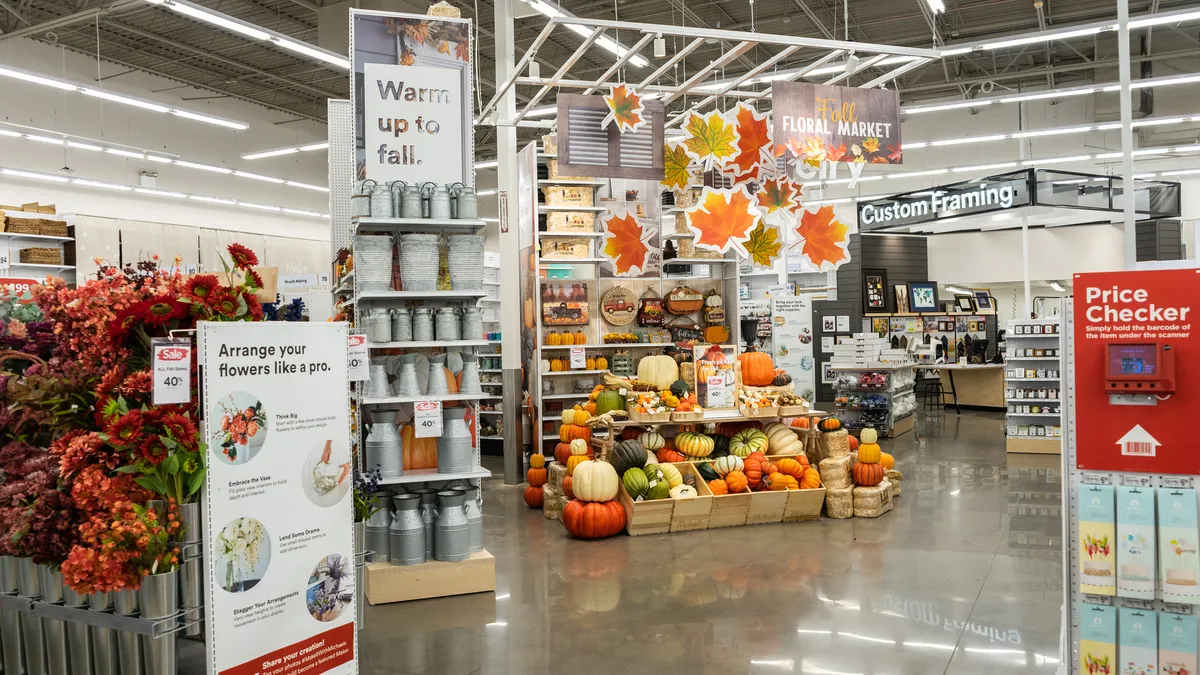For various nonessential retailers, including Michaels, the COVID-19 pandemic was particularly bleak in March. At that time, the crafts retailer had temporarily closed stores and declined to share estimates for its performance with investors. S&P Global downgraded the company, alongside others like At Home Group and the Container Store. Eight months into the pandemic-induced economic disruption, however, the retailer has seemingly found its footing.
In its second quarter, Michaels reported a net sales increase of 11.1% to $1.1 billion. The retailer also saw 353% in e-commerce growth. In early July, the company reopened its brick-and-mortar stores, and it launched several initiatives between August and early September, including new rewards program perks, a MichaelsPro program for makers and two concept stores in Texas.
"As our stores reopen in the quarter, we saw an immediate and sustained recovery in demand that largely kept pace with what we have initially seen in May," Ashley Buchanan, CEO of Michaels, said during the company's Sept. 3 earnings call, according to a Seeking Alpha transcript. "Overall I'm very pleased with this quarter's progress in reducing friction points from the shopping experience," Buchanan added. "Importantly, we have significant runway and will continue to ... innovate in the coming quarters."
As the pandemic stretches on, it's unclear how long it will take the economy to fully recover. As Michaels emerges with a bright second quarter, experts told Retail Dive that the crafts company's sales growth could continue through the end of the year as consumers shift their spending to artistic hobbies. The retailer's investments in both brick-and-mortar stores and its omnichannel experience will likely benefit the company for the duration of the pandemic and beyond, experts say.
In its second quarter earnings announcement, the company attributed its substantial e-commerce growth to its omnichannel capabilities, such as curbside pickup, ship from store, same-day delivery, BOPIS and in-app purchases. Such digital functionality follows other retailers like Walmart and Target and will be critical for stores, particularly specialty retailers, because it's difficult for stores to prosper without offering customers that flexibility, said Matt Sargent, principal at Sargent Up North.
"If you're a Costco, you can kind of get away from having some of those options, because people are dedicated to making that trip every week or every two weeks," Sargent said. "But if you're someone like Michaels, where people aren't engaging with you every week, you really have to make [the experience] as smooth as possible."
And though the company has invested in its e-commerce operations, executives also cited the federal stimulus from the CARES Act and the impact of the COVID-19 pandemic on consumers' living situations as reasons for the retailer's overall sales bump. (House Democrats have introduced a new stimulus bill with direct stimulus payments and unemployment benefits, but negotiations had stalled as of press time). Shoppers have spent at a higher level than expected, but there remains uncertainty surrounding congressional negotiations of a second stimulus bill, said Cristina Fernández, senior research analyst at Telsey Advisory Group.
"We believe that COVID-19 is providing some strong tailwinds for our business resulting from lifestyle changes such as more time at home, and the need for creative outlets, as well as [some] broader macro trends impacting the rest of [the] market," Buchanan said during the call.
"That's what's interesting about crafting is that it does connect people, and people are willing to spend on that."

Matt Sargent
Principal, Sargent Up North
Per the Bureau of Labor Statistics' Oct. 5 figures, the September unemployment rate was 7.9%. Though many consumers may be struggling financially as a result of the pandemic, they're also not spending money on other expenses like travel or cars, Sargent said. Echoing Buchanan's point, Sargent said consumers are likely refocusing their attention on home improvement or other "familiar joy" purchases.
"That's what's interesting about crafting is that it does connect people, and people are willing to spend on that," Sargent said. "I think despite the fact that a lot of people are in economic hardship, I think the spending on crafting will continue to accelerate throughout the New Year."
Michaels' launch of its MichaelsPro program, which provides resources for craft entrepreneurs without charging a membership fee, appears to be targeting entrepreneurial party planners or crafters who sell on Etsy or other platforms and want to buy in bulk at a lower price, Fernández said.
Fernández said it's too early to tell how the program will impact the company, given that it's only been in effect since late August. Sargent said its entry into the business-to-business realm makes sense, because it can be more profitable than serving consumers alone, citing retailers in the adjacent office supply category like OfficeMax, Staples and Amazon.
"It's clear to us that there is a subset of customers that want to buy both products from us as they have either a side business or a side hobby ... or it is a full-time business for them," Buchanan said during the earnings call. "They wanted really competitive pricing on both products and we view that as a necessary extension to our offerings for that customer and they told us about what they wanted and we delivered."
Though it's not clear how long the coronavirus pandemic will continue, Michaels is testing out two concept stores in Texas. The locations are designed to let customers easily explore the space, test out products prior to purchase, take crafting classes and watch instructor-led projects on display screens.
Investing in a re-imagined physical store could be the right long-term move for Michaels given that consumers have been returning to stores and wearing masks, Sargent said. For now, the in-store experience can't be replicated for special categories like apparel, furniture and even electronics, he said.
"Any category where inspiration is key needs to have physical engagement," Sargent said. "It's hard to some degree to do that completely digitally."
Among the issues weighing down Michaels' pandemic success are its outstanding debt, U.S. tariffs imposed on Chinese imports, and shipping costs on e-commerce sales, per Fernández and a Telsey Advisory Group report from Sept. 3. The tariffs imposed on Chinese imports at 25% increase the cost of products, but the company will likely have absorbed those costs by next year, Fernández said.
The maturity on its debt is a few years away, but it would be wise for the company to address its $2.63 billion in long-term debt over time Fernández, said, adding that retail investors are concerned about high debt. Though its omnichannel efforts may drive sales, the shipping costs associated with mailing items to consumers' homes take away from the retailer's profit margin.
"That's [why you] don't like to see retailers with long leverage, because when times get tough, you see a lot of bankruptcies like we're seeing during the pandemic," Fernández said. "Michaels has fortunately seen better trends, but we would like to see them address that over time."
Michaels was hesitant to make predictions about the future in its quarterly earnings report, but Telsey Advisory Group estimates that the company will continue to see a similar sales rate in the third quarter, about 6% sales rate in the fourth quarter, and a normal sales rate in the future, Fernández said. The boost in sales overall will subside some time in the second half of next year or later on as people return to the office and resume activities outside of the home, she said.
"Our expectation is that you'll probably see elevated strong sales here very near term just because consumers are spending a lot of time at home where they're working at home or virtual learning," Fernández said. "That should abate over time and kind of go back to normal."



















